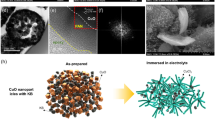Abstract
Cu2O/Cu composite has been widely used as a photocatalyst for hydrogen production. However, little attention has been paid to the electrochemical performance of Cu2O/Cu composite in Li-ion batteries (LIBs). Natural clay sepiolite is an impressive inorganic template for the nanocrystallization of functional materials. Besides, the sepiolite shows high wettability towards liquid electrolytes and its pseudocapacitive behavior can increase the specific discharge capacity of the electrodes. Thus, in this paper, natural clay sepiolite was employed to prepare a nanosized sepiolite/Cu2O/Cu ternary composite anode for LIBs. The as-prepared environmentally friendly sepiolite/Cu2O/Cu anode shows excellent electrochemical performance compared with Cu2O and sepiolite. The ternary composite can deliver a specific discharge capacity around 650 mAhg−1 and 295 mAhg−1 at 0.1 A g−1 and 1.0 A g−1, respectively.






Similar content being viewed by others
References
Xie A et al (2019) Three-dimensional nanoflower MnCrOx/sepiolite catalyst with increased SO2 resistance for NH3-SCR at low temperature. Chem Eng J 370:897–905
Chen Q et al (2018) Self-templating synthesis of silicon nanorods from natural sepiolite for high-performance lithium-ion battery anodes. J Mater Chem A 6(15):6356–6362
Deng C et al (2019) Sepiolite-based separator for advanced Li-ion batteries. Appl Surf Sci 484:446–452
Lescano L et al (2014) Alternative methodologies for sepiolite defibering. Appl Clay Sci 95:378–382
Valentín JL et al (2007) Novel anhydrous unfolded structure by heating of acid pre-treated sepiolite. Appl Clay Sci 36(4):245–255
Alonso-Domínguez D et al (2018) New Fe2O3-clay@C nanocomposite anodes for Li-ion batteries obtained by facile hydrothermal processes. Nanomaterials 8(10):808
Hou K et al (2017) Tin oxide-carbon-coated sepiolite nanofibers with enhanced lithium-ion storage property. Nanoscale Res Lett 12(1):215
Jiang W et al (2020) Novel sepiolite-based materials for lithium- and sodium-ion storage. Energ Technol 8(3):1901262
Zhou G et al (2010) Graphene-wrapped Fe3O4 anode material with improved reversible capacity and cyclic stability for lithium ion batteries. Chem Mater 22(18):5306–5313
Ding Y et al (2008) Synthesis and electrochemical properties of Co3O4 nanofibers as anode materials for lithium-ion batteries. Mater Lett 62(19):3410–3412
Li X, Dhanabalan A, Wang C (2011) Enhanced electrochemical performance of porous NiO–Ni nanocomposite anode for lithium ion batteries. J Power Sources 196(22):9625–9630
Ding Y et al (2011) Preparation of graphene/TiO2 anode materials for lithium-ion batteries by a novel precipitation method. Mater Res Bull 46(12):2403–2407
Yang Z et al (2018) Hierarchical C/SiOx/TiO2 ultrathin nanobelts as anode materials for advanced lithium ion batteries. Nanotechnology 29(40):405602
Subalakshmi P, Sivashanmugam A (2017) CuO nano hexagons, an efficient energy storage material for Li- ion battery application. J Alloy Compd 690:523–531
Ko S et al (2012) Mesoporous CuO particles threaded with CNTs for high-performance lithium-ion battery anodes. Adv Mater 24(32):4451–4456
Wang C et al (2014) Morphology-dependent performance of CuO anodes via facile and controllable synthesis for lithium-ion batteries. ACS Appl Mater Interfaces 6(2):1243–1250
Huang XH et al (2011) Porous ZnO nanosheets grown on copper substrates as anodes for lithium ion batteries. Electrochim Acta 56(14):4960–4965
Sun J et al (2020) V2O3/MoS2 microspheres as a high-performance anode for Li-storage. Applied Surface Science 513:145756
Li L, Raji A-RO, Tour JM (2013) Graphene-wrapped MnO2–graphene nanoribbons as anode materials for high-performance lithium ion batteries. Adv Mater 25(43):6298–6302
Yin Z et al (2012) CuO/polypyrrole core–shell nanocomposites as anode materials for lithium-ion batteries. Electrochem Commun 20:40–43
Mai YJ et al (2011) CuO/graphene composite as anode materials for lithium-ion batteries. Electrochim Acta 56(5):2306–2311
Li N et al (2013) Microwave-assisted synthesis of dual-conducting Cu2O@Cu–graphene system with improved electrochemical performance as anode material for lithium batteries. Chem Asian J 8(9):1960–1965
Zhou H et al (2018) Facile one-step synthesis of Cu2O@Cu sub-microspheres composites as anode materials for lithium ion batteries. J Mater Sci Technol 34(7):1085–1090
Liu H et al (2021) Stimulating the reversibility of Sb2S3 anode for high-performance potassium-ion batteries. Small 17(10):2008133
Li X-Y, Qu J-K, Yin H-Y (2021) Electrolytic alloy-type anodes for metal-ion batteries. Rare Met 40(2):329–352
Jiang W et al (2021) Preparation and electrochemical properties of sepiolite supported Co3O4 nanoparticles. Appl Clay Sci 203:106020
Yang Y et al (2016) In-situ growth of self-assembled 3D Cu2O@Cu foam with enhanced electrochemical properties. Electrochim Acta 221:56–61
Li P et al (2018) Concave structure of Cu2O truncated microcubes: PVP assisted 100 facet etching and improved facet-dependent photocatalytic properties. CrystEngComm 20(41):6580–6588
Hu X et al (2019) Synthesis of novel ternary heterogeneous BiOCl/TiO2/sepiolite composite with enhanced visible-light-induced photocatalytic activity towards tetracycline. J Colloid Interface Sci 533:238–250
Dou H et al (2018) Band structure engineering of graphitic carbon nitride via Cu2+/Cu+ doping for enhanced visible light photoactivity. Mater Chem Phys 214:482–488
He J et al (2017) Construction of Z-scheme Cu2O/Cu/AgBr/Ag photocatalyst with enhanced photocatalytic activity and stability under visible light. Appl Catal B 203:917–926
Cao K et al (2020) Boosting coulombic efficiency of conversion-reaction anodes for potassium-ion batteries via confinement effect. Adv Func Mater 30(52):2007712
Liu H et al (2022) Heterostructure engineering of ultrathin SnS2/Ti3C2Tx nanosheets for high-performance potassium-ion batteries. J Colloid Interface Sci 606:167–176
Yang R et al (2020) Improved electrochemical performance of ternary Sn–Sb–Cu nanospheres as anode materials for lithium-ion batteries. Rare Met 39(10):1159–1164
Hu Z-L et al (2021) Graphene oxide wrapped magnetic nanoparticle composites induced by SiO2 coating with excellent regenerability. Int J Miner Metall Mater 28(12):2001–2007
Wang Q et al (2021) Three-dimensional antimony sulfide anode with carbon nanotube interphase modified for lithium-ion batteries. Int J Miner Metall Mater 28(10):1629–1635
Funding
This work was financially supported by the National Natural Science Foundation of China (No. 51702371), High-level Talent Gathering Project in Hunan Province (2019RS1059), and Natural Science Foundation of Hunan Province (No. 2019JJ40093).
Author information
Authors and Affiliations
Corresponding author
Ethics declarations
Conflict of interest
The authors declare no competing interests.
Additional information
Publisher's note
Springer Nature remains neutral with regard to jurisdictional claims in published maps and institutional affiliations.
Supplementary Information
Below is the link to the electronic supplementary material.
Rights and permissions
About this article
Cite this article
Zhou, J., Jiang, W., Peng, J. et al. An environmentally friendly sepiolite/Cu2O/Cu ternary composite as anode material for Li-ion batteries. Ionics 28, 1091–1098 (2022). https://doi.org/10.1007/s11581-021-04432-z
Received:
Revised:
Accepted:
Published:
Issue Date:
DOI: https://doi.org/10.1007/s11581-021-04432-z




